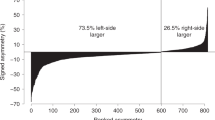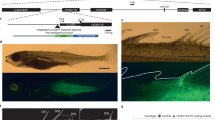Abstract
Hindlimb loss has evolved repeatedly in many different animals by means of molecular mechanisms that are still unknown. To determine the number and type of genetic changes underlying pelvic reduction in natural populations, we carried out genetic crosses between threespine stickleback fish with complete or missing pelvic structures. Genome-wide linkage mapping shows that pelvic reduction is controlled by one major and four minor chromosome regions. Pitx1 maps to the major chromosome region controlling most of the variation in pelvic size. Pelvic-reduced fish show the same left–right asymmetry seen in Pitx1 knockout mice, but do not show changes in Pitx1 protein sequence. Instead, pelvic-reduced sticklebacks show site-specific regulatory changes in Pitx1 expression, with reduced or absent expression in pelvic and caudal fin precursors. Regulatory mutations in major developmental control genes may provide a mechanism for generating rapid skeletal changes in natural populations, while preserving the essential roles of these genes in other processes.
This is a preview of subscription content, access via your institution
Access options
Subscribe to this journal
Receive 51 print issues and online access
$199.00 per year
only $3.90 per issue
Buy this article
- Purchase on Springer Link
- Instant access to full article PDF
Prices may be subject to local taxes which are calculated during checkout





Similar content being viewed by others
References
Darwin, C. The Origin of Species 450–456 (John Murray, London, 1859)
Struthers, J. On the bones, articulations, and muscles of the rudimentary hind-limb of the Greenland right-whale (Balaena mysticetus). J. Anat. Phys. 15, 141–176, 302–321 (1881)
Bejder, L. & Hall, B. K. Limbs in whales and limblessness in other vertebrates: mechanisms of evolutionary and developmental transformation and loss. Evol. Dev. 4, 445–458 (2002)
Lande, R. Evolutionary mechanisms of limb loss in tetrapods. Evolution 32, 73–92 (1978)
Cohn, M. J. & Tickle, C. Developmental basis of limblessness and axial patterning in snakes. Nature 399, 474–479 (1999)
Hoogland, R. D., Morris, D. & Tinbergen, N. The spines of sticklebacks (Gasterosteus and Pygosteus) as means of defense against predators (Perca and Esox). Behaviour 10, 205–230 (1957)
Reimchen, T. E. Structural relationships between spines and lateral plates in threespine stickleback (Gasterosteus aculeatus). Evolution 37, 931–946 (1983)
Bell, M. A. Reduction and loss of the pelvic girdle in Gasterosteus (Pisces): a case of parallel evolution. Nat. Hist. Mus. LA Contrib. Sci. 257, 1–36 (1974)
Moodie, G. E. E. & Reimchen, T. Phenetic variation and habitat differences in Gasterosteus populations of the Queen Charlotte Islands. Syst. Zool. 25, 49–61 (1976)
Campbell, R. N. & Williamson, R. B. The fishes of inland waters in the Outer Hebrides. Proc. R. Soc. Edinb. 77B, 377–393 (1979)
Edge, T. A. & Coad, B. W. Reduction of the pelvic skeleton in the three-spined stickleback Gasterosteus aculeatus in 2 lakes of Quebec Canada. Can. Field-Nat. 97, 334–336 (1983)
Bell, M. A. Interacting evolutionary constraints in pelvic reduction of threespine sticklebacks, Gasterosteus aculeatus (Pisces, Gasterosteidae). Biol. J. Linn. Soc. 31, 347–382 (1987)
Reimchen, T. E. Spine deficiency and polymorphism in a population of Gasterosteus aculeatus—an adaptation to predators. Can. J. Zool. 58, 1232–1244 (1980)
Reist, J. D. Predation upon pelvic phenotypes of brook stickleback, Culaea inconstans, by selected invertebrates. Can. J. Zool. 58, 1253–1258 (1980)
Giles, N. The possible role of environmental calcium levels during the evolution of phenotypic diversity in Outer-Hebridean populations of the three-spined stickleback, Gasterosteus aculeatus. J. Zool. 199, 535–544 (1983)
Bell, M. A., Orti, G., Walker, J. A. & Koenings, J. P. Evolution of pelvic reduction in threespine stickleback fish—a test of competing hypotheses. Evolution 47, 906–914 (1993)
Ziuganov, V. V. & Zotin, A. A. Pelvic girdle polymorphism and reproductive barriers in the ninespine stickleback Pungitius pungitius (L.) from northwest Russia. Behaviour 132, 1095–1105 (1995)
Bell, M. A., Baumgartner, J. V. & Olson, E. C. Patterns of temporal change in single morphological characters of a Miocene stickleback fish. Paleobiology 11, 258–271 (1985)
McPhail, J. D. Ecology and evolution of sympatric sticklebacks (Gasterosteus): evidence for a species pair in Paxton Lake, Texada Island, British Columbia. Can. J. Zool. 70, 361–369 (1992)
Peichel, C. L. et al. The genetic architecture of divergence between threespine stickleback species. Nature 414, 901–905 (2001)
Crow, J. F. & Kimura, M. An Introduction to Population Genetics Theory 182–183 (Burgess, Minneapolis, 1970)
Gibson-Brown, J. J. et al. Evidence of a role for T-box genes in the evolution of limb morphogenesis and the specification of forelimb/hindlimb identity. Mech. Dev. 56, 93–101 (1996)
Logan, M., Simon, H. G. & Tabin, C. Differential regulation of T-box and homeobox transcription factors suggests roles in controlling chick limb-type identity. Development 125, 2825–2835 (1998)
Logan, M. & Tabin, C. J. Role of Pitx1 upstream of Tbx4 in specification of hindlimb identity. Science 283, 1736–1739 (1999)
Lanctôt, C., Moreau, A., Chamberland, M., Tremblay, M. L. & Drouin, J. Hindlimb patterning and mandible development require the Ptx1 gene. Development 126, 1805–1810 (1999)
Szeto, D. P. et al. Role of the Bicoid-related homeodomain factor Pitx1 in specifying hindlimb morphogenesis and pituitary development. Genes Dev. 13, 484–494 (1999)
Marcil, A., Dumontier, E., Chamberland, M., Camper, S. A. & Drouin, J. Pitx1 and Pitx2 are required for development of hindlimb buds. Development 130, 45–55 (2003)
Shang, J., Luo, Y. & Clayton, D. A. Backfoot is a novel homeobox gene expressed in the mesenchyme of developing hind limb. Dev. Dyn. 209, 242–253 (1997)
Campione, M. et al. The homeobox gene Pitx2: mediator of asymmetric left-right signaling in vertebrate heart and gut looping. Development 126, 1225–1234 (1999)
Naiche, L. A. & Papaioannou, V. E. Loss of Tbx4 blocks hindlimb development and affects vascularization and fusion of the allantois. Development 130, 2681–2693 (2003)
Bruneau, B. G. et al. A murine model of Holt-Oram syndrome defines roles of the T-box transcription factor Tbx5 in cardiogenesis and disease. Cell 106, 709–721 (2001)
Garrity, D. M., Childs, S. & Fishman, M. C. The heartstrings mutation in zebrafish causes heart/fin Tbx5 deficiency syndrome. Development 129, 4635–4645 (2002)
Carroll, S. B. Endless forms: the evolution of gene regulation and morphological diversity. Cell 101, 577–580 (2000)
Stern, D. L. Evolutionary developmental biology and the problem of variation. Evolution 54, 1079–1091 (2000)
Tautz, D. Evolution of transcriptional regulation. Curr. Opin. Genet. Dev. 10, 575–579 (2000)
Stern, D. L. A role of Ultrabithorax in morphological differences between Drosophila species. Nature 396, 463–466 (1998)
Sucena, E. & Stern, D. L. Divergence of larval morphology between Drosophila sechellia and its sibling species caused by cis-regulatory evolution of ovo/shaven-baby. Proc. Natl Acad. Sci. USA 97, 4530–4534 (2000)
Kopp, A., Duncan, I., Godt, D. & Carroll, S. B. Genetic control and evolution of sexually dimorphic characters in Drosophila. Nature 408, 553–559 (2000)
Beldade, P., Brakefield, P. M. & Long, A. D. Contribution of Distal-less to quantitative variation in butterfly eyespots. Nature 415, 315–318 (2002)
van Laere, A. S. et al. A regulatory mutation in IGF2 causes a major QTL effect on muscle growth in the pig. Nature 425, 832–836 (2003)
Schwartz, S. et al. Human-mouse alignments with BLASTZ. Genome Res. 13, 103–107 (2003)
Cole, N. J., Tanaka, M., Prescott, A. & Tickle, C. Expression of limb initiation genes and clues to the morphological diversification of threespine stickleback. Curr. Biol. 13, R951–R952 (2003)
Bell, M. A., Francis, R. C. & Havens, A. C. Pelvic reduction and its directional asymmetry in threespine sticklebacks from the Cook Inlet region, Alaska. Copeia 1985, 437–444 (1985)
Nelson, J. S. Evidence of a genetic basis for absence of pelvic skeleton in brook stickleback, Culaea inconstans, and notes on geographical distribution and origin of loss. J. Fish. Res. Board Can. 34, 1314–1320 (1977)
Nelson, J. S. Absence of pelvic complex in ninespine sticklebacks, Pungitius pungitius, collected in Ireland and Wood Buffalo National Park region, Canada, with notes on meristic variation. Copeia 1971, 707–717 (1971)
van Ooijen, J. W. & Maliepard, C. MapQTL Version 3.0: Software for the Calculation of QTL Positions and Genetic Maps (Centre for Plant Breeding and Reproductive Research, Wageningen, 1996)
Ross, M. T., LaBrie, S., McPherson, J. & Stanton, V. P. in Current Protocols in Human Genetics (ed. Dracopoli, N.) (Wiley, New York, 1999)
Wilkinson, D. G. in Essential Developmental Biology: A Practical Approach (eds Stern, C. D. & Holland, P. W. H.) 257–274 (IRL Press, Oxford, 1993)
Swarup, H. Stages in the development of the stickleback Gasterosteus aculeatus (L.). J. Embryol. Exp. Morphol. 6, 373–383 (1958)
Van Ooijen, J. W. LOD significance thresholds for QTL analysis in experimental populations of diploid species. Heredity 83, 613–624 (1999)
Acknowledgements
We thank S. Mori for providing marine sticklebacks; E. Elfarsdóttir, G. I. Gudbrandsson, L. E. Jónsdóttir, S. Ingólfsdóttir and K. Einarsdóttir for collecting Icelandic sticklebacks and scoring the parental population from Vífilsstadavatn; and F. Chan and members of the Kingsley laboratory for discussions. This work was supported in part by grants from the National Institutes of Health (to D.M.K.), the Natural Sciences and Engineering Research Council of Canada and the Canada Foundation for Innovation (to D.S.), and the City of Gardabaer (to B.J.); a Helen Hay Whitney Foundation postdoctoral fellowship (to M.D.S.); and a Howard Hughes Medical Institute predoctoral fellowship (to M.E.M). D.S. is a Canada Research Chair, and D.M.K. is an Associate Investigator of the Howard Hughes Medical Institute.
Author information
Authors and Affiliations
Corresponding author
Ethics declarations
Competing interests
The authors declare that they have no competing financial interests.
Supplementary information
Supplementary Information
List of microsatellite markers used in Figure 1 of main text; and Supplementary Table 1: Comparison of the effect of modifier QTL in animals with different genotypes at the Pitx1 locus. (DOC 100 kb)
Rights and permissions
About this article
Cite this article
Shapiro, M., Marks, M., Peichel, C. et al. Genetic and developmental basis of evolutionary pelvic reduction in threespine sticklebacks. Nature 428, 717–723 (2004). https://doi.org/10.1038/nature02415
Received:
Accepted:
Issue Date:
DOI: https://doi.org/10.1038/nature02415
This article is cited by
-
Genomewide architecture of adaptation in experimentally evolved Drosophila characterized by widespread pleiotropy
Journal of Genetics (2024)
-
Context-dependent enhancer function revealed by targeted inter-TAD relocation
Nature Communications (2022)
-
Chromosome-level genome assembly of largemouth bass (Micropterus salmoides) using PacBio and Hi-C technologies
Scientific Data (2022)
-
Integration of multi-omics data reveals cis-regulatory variants that are associated with phenotypic differentiation of eastern from western pigs
Genetics Selection Evolution (2022)
-
Multiple loci linked to inversions are associated with eye size variation in species of the Drosophila virilis phylad
Scientific Reports (2020)
Comments
By submitting a comment you agree to abide by our Terms and Community Guidelines. If you find something abusive or that does not comply with our terms or guidelines please flag it as inappropriate.



